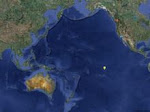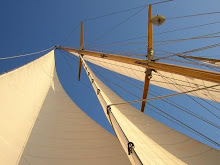Listening to the weather report on the VHF radio used to be a stressful activity for me. That metallic voice, vaguely female, with her inflections out of sync with the rhythm of her speaking, would always inspire my heart to race. One of the first times I heard this report was during our sail from Friday Harbor to San Diego. We hit a patch of heavy weather off the coast of Oregon, and we were listening to the VHF to see how much longer this unpredicted weather was supposed to last. Bad news… more than a week of 40+ knot winds, seas building to 20 feet or more, and all the safe harbor entrances were closed due to severe wave conditions across the shallow sandbars at the mouths of the bays. I guess I took it personally. I decided I didn't like that weather girl.
Leaving San Diego, we listened to the VHF radio traffic so that we could avoid any activity by the Navy ships outside of the bay. Every once in a while, a woman from the Coast Guard would read off the marine weather forecast. This was a real woman reading the NOAA predictions, not a computer-generated voice. That was a nice change, except that this woman had obviously heard way too many VHF forecasts. The inflection errors were eerily similar to the electronc weather girl. I almost gave a laugh at the irony. "Small Craft Advisory," she said. I didn't laugh. I didn't like her either.
Glenn and I had been monitoring the weather forecasts for over a week. I don't remember anything about a small craft advisory as far south as San Diego and Guadalupe Island. We told ourselves that the advisory was probably aimed at the Channel Islands to the north. Surely, the weather would abate as we sailed further south. Well, that may have been the case, but the first few days out of the bay were a bit too boisterous for our bellies. All hands and paws on board were seasick within the first 24 hours.
Each of us seemed to respond differently to feeling seasick. Nemo's stragtegy was to bury his head in a pile of lifejackets at the very bow of the boat for a full day. I was doing okay until the seas got rough enough to dislodge Nemo's litter pan. I had been dealing with pots banging, drawers opening of their own accord, bags of pasta and bottles of shampoo on the floor… But, the litter pan sent me over the edge. I adopted Nemo's tactic. I laid down on leeward setee, threw the neareast blanket over my head, and didn't come out of my stupor for hours.
Glenn seemed confused by the onset of symptoms. Lethargy and weakness are not common feelings for him. But, then again, neither is seasickness. Luckily for us, his strategy for dealing with it was to stay outside in the wind, watching the horizon. At least one of us was watching!
On our trip down to San Diego, we had found that hard-boiled eggs were the best food to eat to help with seasickness. They are bland, filling, and easy to grab on your way out to the cockpit to watch the horizon. During the past week, apples were our primary food of choice. I had pre-made a bunch of meals, anticipating that I wouldn't feel like cooking, but I hadn't anticipated not feeling like eating at all!
I was the first of us to fully recover. I slowly picked up the rubble that had accumulated, and stopped the drawers from opening. I needed to make the area more kitty friendly before coaxing Nemo out of hiding. I also shoved a multitude of hand towels and canvas bags into crevices throughout the boat to stop things from sliding, banging, and clinking. These noises were tiresome to us, but downright alarming to Nemo. I then set to work building a new "nest" for Nemo to hide in which was in the main cabin area where we could interact with him better. At first, his disapproval of the situation was palpable. But, he was easily bribed into civility and relative ease with some spoon-fed homemade applesauce and a black fleecey sweatshirt to lay on. I later upped the ante with a helping of his favorite dish - tuna and egg! Mmmm. Purr.
Glenn's malady was persistent until, at last, he was able to go below and sleep it off. He awoke hours later ravenous. After eating only apples and drinking water for three days, he needed food. What did he find? Not another hard-boiled egg, but spicy nuts with chile and lime seasoning, of course! Not my first choice, but it worked for him.
Now we are settling into a schedule of sorts. I'm baking breads and preparing real dinners. I have to take stock of our produce supply - we're almost out of apples now! But, neither of us seems too keen on eating the remaining couple of apples anyway.
Our current position is N17° 07.6'; W120° 50.7'. We're headed slightly west of south now (190 °) in calmer seas (southward swell of ~2 feet) with force 4 winds pushing us along at 5 knots. It's starting to feel a bit more tropical. The air temperature is about 80 °F and the water temperature is 71.9 °F. Humidity isn't too high yet (52%). The sky is partly cloudy. The barometer reads 1017 millibars. Now, this is the weather I approve of.
Happy Cinco de Mayo!


